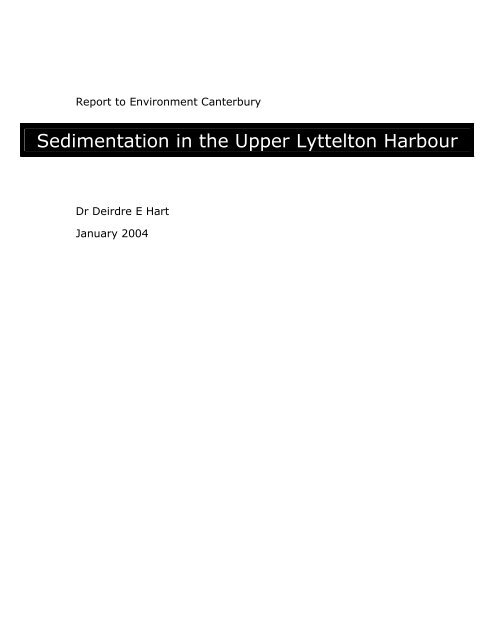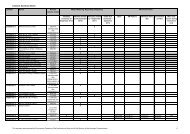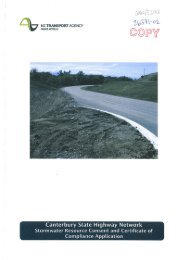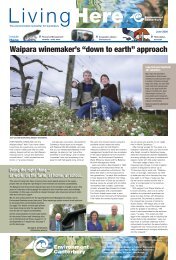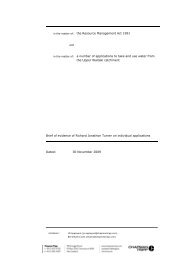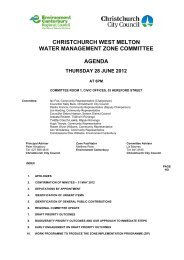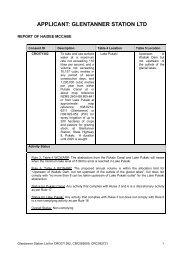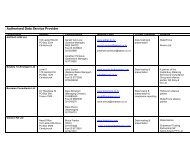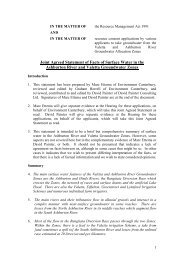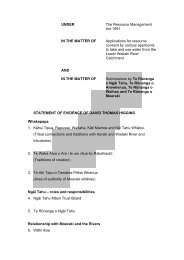Sedimentation in the Upper Lyttelton Harbour - Environment ...
Sedimentation in the Upper Lyttelton Harbour - Environment ...
Sedimentation in the Upper Lyttelton Harbour - Environment ...
Create successful ePaper yourself
Turn your PDF publications into a flip-book with our unique Google optimized e-Paper software.
CONTENTS<br />
Introduction 4<br />
• Scope and Purpose of <strong>the</strong> Report 4<br />
• Physiographic Settl<strong>in</strong>g 4<br />
• <strong>Upper</strong> <strong>Harbour</strong> Stability 5<br />
Hydrodynamic Conditions 5<br />
• Waves 6<br />
• Tidal Circulation 6<br />
Sediment Sources 8<br />
• Catchment Erosion 8<br />
• Pegasus Bay 8<br />
• <strong>Harbour</strong> Dredg<strong>in</strong>g 9<br />
Patterns of <strong>Sedimentation</strong> 10<br />
• Sediment Texture 10<br />
• Chang<strong>in</strong>g Bed Levels 11<br />
• Sediment Transport 12<br />
Conclusions 13<br />
Options for Fur<strong>the</strong>r Investigation 14<br />
• Marker Stakes 14<br />
• Artificial Marker Horizons 14<br />
• Bathymetric Surveys 14<br />
• Surface Sediment Analysis 14<br />
• Core Sample Analysis 15<br />
Acknowledgements 15<br />
References 16
4<br />
Scope and Purpose of <strong>the</strong> Report<br />
Introduction<br />
This report concerns <strong>the</strong> coastal processes operat<strong>in</strong>g <strong>in</strong> <strong>the</strong> <strong>Upper</strong> <strong>Lyttelton</strong> <strong>Harbour</strong><br />
(43º41’ South, 172º41’ East) with particular reference to <strong>the</strong> patterns and processes<br />
of sedimentation <strong>in</strong> Governor’s Bay, Head of <strong>the</strong> Bay and Charteris Bay (Figure 1).<br />
The purpose of <strong>the</strong> report is to review current <strong>in</strong>formation and data on sedimentation<br />
<strong>in</strong> <strong>the</strong> <strong>Upper</strong> <strong>Lyttelton</strong> <strong>Harbour</strong> and to explore possibilities for fur<strong>the</strong>r <strong>in</strong>vestigation<br />
and monitor<strong>in</strong>g. Published and unpublished reports and <strong>the</strong>ses have been used<br />
along with maps, aerial photographs, hydrographic charts and structural bluepr<strong>in</strong>ts<br />
and plans. In addition, a brief field <strong>in</strong>vestigation was conducted on 15/12/03.<br />
Numerous reports have exam<strong>in</strong>ed patterns of circulation, sedimentation and ecology<br />
with<strong>in</strong> <strong>the</strong> wider area of <strong>Lyttelton</strong> <strong>Harbour</strong>, predom<strong>in</strong>antly for <strong>the</strong> purposes of<br />
assess<strong>in</strong>g <strong>the</strong> impact of port dredg<strong>in</strong>g operations (Brodie 1955, Bushell and Teear<br />
1975, Millhouse 1977, Curtis 1985, 1986, Knox 1983, 1988, Kirk 1992, 1993, Barter<br />
2000). Where it perta<strong>in</strong>s to <strong>the</strong> processes operat<strong>in</strong>g with<strong>in</strong> or affect<strong>in</strong>g <strong>the</strong> upper<br />
harbour environment, <strong>in</strong>formation from <strong>the</strong>se and o<strong>the</strong>r studies is used throughout<br />
this report.<br />
In <strong>the</strong> first part of this report, <strong>the</strong> physiographic settl<strong>in</strong>g of <strong>Lyttelton</strong> <strong>Harbour</strong> is<br />
outl<strong>in</strong>ed, <strong>in</strong>clud<strong>in</strong>g aspects of <strong>the</strong> geology, soils and catchment landuse relevant to<br />
<strong>the</strong> sediment budget of <strong>the</strong> <strong>in</strong>let. Attention is also drawn to <strong>the</strong> natural process of<br />
<strong>in</strong>let <strong>in</strong>fill<strong>in</strong>g. Next, <strong>the</strong> major hydrodynamic <strong>in</strong>fluences operat<strong>in</strong>g with<strong>in</strong> <strong>the</strong> harbour,<br />
<strong>the</strong> waves and tides, are exam<strong>in</strong>ed. In <strong>the</strong> subsequent two sections, sources of<br />
sediment for <strong>the</strong> upper harbour and patterns and processes of sediment transport<br />
throughout <strong>the</strong> harbour and towards <strong>the</strong> head are discussed. The f<strong>in</strong>al section of this<br />
report comprises an outl<strong>in</strong>e of possible options for fur<strong>the</strong>r <strong>in</strong>vestigation of <strong>the</strong> rates of<br />
sedimentation <strong>in</strong> <strong>the</strong> <strong>Upper</strong> <strong>Lyttelton</strong> <strong>Harbour</strong>, past and present.<br />
Physiographic Sett<strong>in</strong>g<br />
Situated on <strong>the</strong> nor<strong>the</strong>rn side of Banks Pen<strong>in</strong>sula (Hikuraki), <strong>Lyttelton</strong> <strong>Harbour</strong> is a<br />
15ikm long, rock-walled <strong>in</strong>let with an average width of approximately 2 km. In <strong>the</strong><br />
upper harbour, <strong>the</strong> <strong>in</strong>let widens to form three bays: Governor’s Bay, Head of <strong>the</strong> Bay<br />
and Charteris Bay, separated by pen<strong>in</strong>sulas and Quail Island (Figure 1). The<br />
harbour has a low-tide area of approximately 43 km 2 and a central, long axis<br />
oriented <strong>in</strong> an ENE-WSW direction. The Port of <strong>Lyttelton</strong> is situated 9ikm from <strong>the</strong><br />
harbour entrance on <strong>the</strong> nor<strong>the</strong>rn side of <strong>the</strong> harbour. Construction of <strong>the</strong><br />
breakwater arms which enclose <strong>the</strong> <strong>in</strong>ner harbour was carried out dur<strong>in</strong>g <strong>the</strong> period<br />
1863-1876. Port access has been ma<strong>in</strong>ta<strong>in</strong>ed s<strong>in</strong>ce 1849 through extensive channel<br />
dredg<strong>in</strong>g (Curtis 1985).<br />
The wider area of Banks Pen<strong>in</strong>sula comprises two large Miocene (11-8 Ma)<br />
composite volcanic cones, <strong>the</strong> central areas of which have collapsed and been
eroded by streams (Neumayr 1998). Subsequent drown<strong>in</strong>g by <strong>the</strong> sea led to <strong>the</strong><br />
formation of <strong>the</strong> <strong>Lyttelton</strong> and Akaroa <strong>Harbour</strong> <strong>in</strong>lets (Speight 1917). The base of <strong>the</strong><br />
pen<strong>in</strong>sula is engulfed by <strong>the</strong> glacial outwash gravels of <strong>the</strong> Canterbury Pla<strong>in</strong>s, which<br />
also form <strong>the</strong> surround<strong>in</strong>g cont<strong>in</strong>ental shelf. The underly<strong>in</strong>g volcanic rocks of <strong>the</strong><br />
pen<strong>in</strong>sula are commonly mantled by thick ( 20 m) deposits of loess blown from <strong>the</strong><br />
Canterbury Pla<strong>in</strong>s dur<strong>in</strong>g <strong>the</strong> Pleistocene and loess colluvium (volcanic detritus).<br />
This f<strong>in</strong>e sediment is readily eroded from <strong>the</strong> hill slopes and transported to <strong>the</strong> sea.<br />
Inside <strong>Lyttelton</strong> <strong>Harbour</strong>, steep rocky slopes descend to a near-flat seabed, with an<br />
average gradient of 1 <strong>in</strong> 1000, and a maximum depth of 15.5 m below mean low<br />
water spr<strong>in</strong>gs (MLWS) near <strong>the</strong> harbour entrance (Bushell and Teear 1975). Due to<br />
<strong>the</strong> rocky nature of <strong>the</strong> <strong>in</strong>let sides, harbour adjustments to coastal processes are<br />
largely limited to changes <strong>in</strong> <strong>the</strong> bed. Fluvial <strong>in</strong>puts to harbour are generally small,<br />
averag<strong>in</strong>g approximately 1 m 3 s -1 annually (Heath 1976), although <strong>the</strong>y and <strong>the</strong>ir<br />
sediment load are concentrated <strong>in</strong> <strong>the</strong> upper harbour. Catchment erosion has <strong>in</strong>filled<br />
<strong>the</strong> harbour bas<strong>in</strong> to depths of up to 47 m and resulted <strong>in</strong> <strong>the</strong> formation of extensive<br />
tidal flats <strong>in</strong> Governor’s Bay, Head of <strong>the</strong> Bay and Charteris Bay, which cover a<br />
comb<strong>in</strong>ed area of about 11 km 2 at MLWS (Bushell and Teear 1975).<br />
Dur<strong>in</strong>g <strong>the</strong> last 150 years, vegetation cover and landuse on <strong>the</strong> pen<strong>in</strong>sula have<br />
changed dramatically. Pre-1860, mixed Podocarp forests and dense tussock<br />
grasslands covered approximately two and one thirds of <strong>the</strong> <strong>Lyttelton</strong> <strong>Harbour</strong><br />
catchment respectively. From 1860-1900, over 90% of <strong>the</strong> forests were removed as<br />
a result of timber extraction, widespread burn<strong>in</strong>g and agricultural land clearance<br />
(Johnston 1969). In turn, <strong>the</strong>se landuse changes led to <strong>in</strong>creased catchment soil<br />
erosion and stream sediment yields. Today, much of <strong>the</strong> cleared land around <strong>the</strong><br />
<strong>Lyttelton</strong> <strong>Harbour</strong> catchment is still <strong>in</strong> grassland.<br />
<strong>Upper</strong> <strong>Harbour</strong> Stability<br />
It is important to recognise that <strong>the</strong> heads of coastal <strong>in</strong>lets, such as <strong>Lyttelton</strong><br />
<strong>Harbour</strong>, are naturally <strong>in</strong>fill<strong>in</strong>g features. The large areas of flat land at <strong>the</strong> head of<br />
Governor’s Bay and Head of <strong>the</strong> Bay, for example, represent thousands of years of<br />
accretion, with sediment sourced from erosion of <strong>the</strong> surround<strong>in</strong>g catchment, blown<br />
from <strong>the</strong> Canterbury Pla<strong>in</strong>s and transported from with<strong>in</strong> <strong>the</strong> mar<strong>in</strong>e environment. As<br />
will be detailed later <strong>in</strong> this report, <strong>the</strong> exist<strong>in</strong>g natural process of <strong>in</strong>fill<strong>in</strong>g has, s<strong>in</strong>ce<br />
<strong>the</strong> arrival of Europeans, been <strong>in</strong>fluenced by anthropogenic modification of <strong>the</strong><br />
harbour sediment supply and hydrodynamics.<br />
Hydrodynamic Conditions<br />
Accord<strong>in</strong>g to <strong>the</strong> classification of Heath (1976), <strong>Lyttelton</strong> <strong>Harbour</strong> is characterised by<br />
a mixture of tidal currents, w<strong>in</strong>d-<strong>in</strong>duced waves and currents and o<strong>the</strong>r motions. As<br />
detailed below, circulation and sedimentation with<strong>in</strong> <strong>the</strong> harbour are atypical of<br />
estuar<strong>in</strong>e and <strong>in</strong>let dynamics, with flow and patterns <strong>in</strong> sediment texture occurr<strong>in</strong>g<br />
parallel to <strong>the</strong> long-axis of <strong>the</strong> harbour, along much of its length. Based on vertical<br />
5
stratification and sal<strong>in</strong>ity profiles, <strong>the</strong> harbour may be divided <strong>in</strong>to three discrete<br />
compartments with exchanges of water and sediment occurr<strong>in</strong>g between <strong>the</strong>m: <strong>the</strong><br />
well-mixed upper and lower harbour sectors and a more stratified central area<br />
separat<strong>in</strong>g <strong>the</strong> two (Figure 1). The average residence time of a unit mass of water<br />
with<strong>in</strong> <strong>the</strong> harbour as a whole is approximately 2.09 days (Millhouse 1977).<br />
Waves<br />
The wave environment of <strong>Lyttelton</strong> <strong>Harbour</strong> comprises a mixture of locally-generated<br />
short-period w<strong>in</strong>d waves (3.5 s) and long-period swell (10-20 s).<br />
The cliffs of <strong>the</strong> harbour funnel <strong>the</strong> prevail<strong>in</strong>g NE and SW w<strong>in</strong>ds along its length,<br />
generat<strong>in</strong>g <strong>the</strong> short-fetch w<strong>in</strong>d waves. These short-period waves are often well<br />
developed at <strong>the</strong> head of <strong>the</strong> harbour. They suspend f<strong>in</strong>e silt deposits throughout<br />
<strong>the</strong> upper harbour, facilitat<strong>in</strong>g <strong>the</strong>ir transport on <strong>the</strong> tidal and o<strong>the</strong>r currents present.<br />
In addition, <strong>the</strong> harbour entrance is exposed to swell of unlimited fetch from <strong>the</strong> ENE<br />
and refracted swell from <strong>the</strong> SE. Curtis (1985) <strong>in</strong>dicates that low-amplitude (1-2 m)<br />
swell waves with periods of 12is and 20is reach <strong>the</strong> harbour 24% and 30% of <strong>the</strong><br />
time respectively. Higher-amplitude (>1.5 m) storm waves with periods of 11is reach<br />
<strong>the</strong> harbour 10% of <strong>the</strong> time. The latter storm waves are more effective <strong>in</strong> terms of<br />
sediment transport. Waves which are sufficiently energetic to entra<strong>in</strong> f<strong>in</strong>e sand-sized<br />
sediment <strong>in</strong> water depths greater than 7 m occur with<strong>in</strong> <strong>the</strong> harbour 47% of <strong>the</strong> time<br />
(Curtis 1985).<br />
Refraction of waves enter<strong>in</strong>g <strong>the</strong> harbour results from <strong>the</strong> <strong>in</strong>fluence of <strong>the</strong> dredged<br />
channel and spoil mounds and, to a lesser degree, <strong>the</strong> natural bathymetry. S<strong>in</strong>ce<br />
<strong>the</strong> 1970s, spoil mounds have been placed strategically <strong>in</strong> <strong>the</strong> outer nor<strong>the</strong>rn bays,<br />
<strong>in</strong>clud<strong>in</strong>g Gollans and Liv<strong>in</strong>gston Bays, and at <strong>the</strong> nor<strong>the</strong>rn side of <strong>the</strong> harbour<br />
entrance. The result<strong>in</strong>g outer harbour wave refraction has produced a major<br />
reduction <strong>in</strong> <strong>the</strong> amount of wave energy reach<strong>in</strong>g <strong>the</strong> upper harbour as well as<br />
provid<strong>in</strong>g calmer conditions with<strong>in</strong> <strong>the</strong> port and slow<strong>in</strong>g <strong>the</strong> rate of dredge spoil recirculation<br />
(Bushell and Teear 1975, Curtis 1986).<br />
Tidal Circulation<br />
<strong>Lyttelton</strong> <strong>Harbour</strong> experiences semi-diurnal tides with ranges of between 1.92 m<br />
dur<strong>in</strong>g perigean (spr<strong>in</strong>g) tides and 1.64 m dur<strong>in</strong>g apogean (neap) tides, with a<br />
maximum tidal range of 2.65 m.<br />
Several <strong>in</strong>vestigations have exam<strong>in</strong>ed tidal currents with<strong>in</strong> <strong>the</strong> harbour, although<br />
almost all focus on central to lower areas. Garner and Ridgway (1955) used dye and<br />
float trac<strong>in</strong>g to measure tidal circulations adjacent to <strong>the</strong> port and <strong>in</strong> <strong>the</strong> lower<br />
harbour. They found current velocities up to 0.25 ms -1 common <strong>in</strong> <strong>the</strong> harbour, with<br />
stronger flows <strong>in</strong> <strong>the</strong> south on <strong>the</strong> flood tide, whilst <strong>the</strong> more stratified ebb tide was<br />
stronger and of greater duration <strong>in</strong> <strong>the</strong> north. The asymmetry of tidal circulation<br />
between <strong>the</strong> nor<strong>the</strong>rn and sou<strong>the</strong>rn sides of <strong>the</strong> harbour was fur<strong>the</strong>r confirmed by<br />
current-meter measurements by Bushell and Teear (1975) and Curtis (1985).<br />
6
In addition, Curtis (1985) described <strong>the</strong> <strong>in</strong>creas<strong>in</strong>g distortion of <strong>the</strong> tide with distance<br />
up <strong>the</strong> harbour. He found that mean tidal velocities <strong>in</strong>creased steadily towards <strong>the</strong><br />
harbour entrance, vary<strong>in</strong>g from 0.15ims -1 west of <strong>the</strong> port, to 0.22-0.23ims -1 <strong>in</strong> <strong>the</strong><br />
central harbour, to 0.26-0.27ims -1 near <strong>the</strong> harbour entrance. Mean current<br />
velocities on <strong>the</strong> ebb and flood tides were 0.23 ms -1 and 0.22 ms -1 respectively.<br />
Figure 2. <strong>Harbour</strong> circulation patterns dur<strong>in</strong>g A) <strong>the</strong> flood tide, and B) <strong>the</strong> ebb tide. Modified from<br />
Curtis (1985, 161).<br />
7
Curtis (1985) suggested that <strong>the</strong> differences <strong>in</strong> tidal current velocities and durations<br />
between <strong>the</strong> two sides of <strong>the</strong> harbour gave rise to transverse, cross-harbour currents<br />
(Figure 2). Fur<strong>the</strong>r, he postulated that <strong>the</strong> <strong>in</strong>teraction of <strong>the</strong>se currents with harbour<br />
topography often led to <strong>the</strong> development of a large clockwise gyre <strong>in</strong> <strong>the</strong> central to<br />
lower harbour on <strong>the</strong> flood tide and a comparable anti-clockwise gyre on <strong>the</strong> ebb<br />
tide. Gyre development was not, however, observed on every tidal cycle and, when<br />
present, <strong>the</strong> gyre operated for 50% of any given tidal cycle. Curtis (1985)<br />
suggested that <strong>the</strong> development of <strong>the</strong> gyre was a function of tidal characteristics,<br />
<strong>in</strong>clud<strong>in</strong>g amplitude and duration, and external <strong>in</strong>fluences, <strong>in</strong>clud<strong>in</strong>g wave and w<strong>in</strong>d<strong>in</strong>duced<br />
current conditions.<br />
Kirk (1992) observed that gyres are frequently visible <strong>in</strong> harbour waters from <strong>the</strong> air,<br />
whilst Spigel (1993a, 1993b), us<strong>in</strong>g dye trac<strong>in</strong>g experiments, confirmed <strong>the</strong> existence<br />
of transverse flows with<strong>in</strong> <strong>the</strong> central and lower harbour. Dye released from <strong>the</strong><br />
vic<strong>in</strong>ity of <strong>the</strong> port breakwater dispersed across <strong>the</strong> harbour with<strong>in</strong> two tidal cycles<br />
and, later, along <strong>the</strong> length of <strong>the</strong> harbour <strong>in</strong>to to <strong>the</strong> entrance of Charteris Bay <strong>in</strong> <strong>the</strong><br />
south, and Cass and Rapaki Bays <strong>in</strong> <strong>the</strong> north.<br />
Sediment Sources<br />
<strong>Sedimentation</strong> with<strong>in</strong> <strong>Lyttelton</strong> <strong>Harbour</strong> may comprise material sourced externally,<br />
from catchment hill slopes or Pegasus Bay, or from sources with<strong>in</strong> <strong>the</strong> harbour,<br />
<strong>in</strong>clud<strong>in</strong>g <strong>the</strong> re-circulation of dredge spoil and erosion of thick bed deposits.<br />
Catchment Erosion<br />
On average, an estimated 44i300itia -1 of loess and loess colluvium is eroded from<br />
<strong>the</strong> <strong>Lyttelton</strong> <strong>Harbour</strong> catchment (Curtis 1985) most of which is deposited with<strong>in</strong> <strong>the</strong><br />
mar<strong>in</strong>e environment of <strong>the</strong> <strong>in</strong>let (Figure 3). These deposits play a major role <strong>in</strong><br />
ma<strong>in</strong>ta<strong>in</strong><strong>in</strong>g high levels of turbidity with<strong>in</strong> <strong>the</strong> <strong>in</strong>let as <strong>the</strong>y are readily suspended by<br />
waves and tidal currents and rema<strong>in</strong> <strong>in</strong> suspension for prolonged periods.<br />
Catchment erosion rates are an order of magnitude greater <strong>in</strong> <strong>the</strong> upper harbour<br />
between Cass Bay and Head of <strong>the</strong> Bay, than along <strong>the</strong> hill slopes adjacent to<br />
central and lower areas of <strong>the</strong> harbour. This erosion is <strong>the</strong> most important source of<br />
external sediment for <strong>the</strong> upper harbour. Fluvial <strong>in</strong>puts are concentrated <strong>in</strong> this area<br />
and s<strong>in</strong>k to <strong>the</strong> bottom of <strong>the</strong> water column where <strong>the</strong>ir sediment load settles out<br />
rapidly.<br />
Pegasus Bay<br />
The volume of sediment enter<strong>in</strong>g <strong>the</strong> harbour from Pegasus Bay is unknown<br />
(Figurei3). The lower harbour and dredged channel, however, likely operate as<br />
efficient s<strong>in</strong>ks for such material, prevent<strong>in</strong>g any from be<strong>in</strong>g transported <strong>in</strong>to <strong>the</strong> upper<br />
harbour.<br />
8
Figure 3. The <strong>Lyttelton</strong> <strong>Harbour</strong> sediment budget, <strong>in</strong>clud<strong>in</strong>g <strong>in</strong>puts from catchment erosion and<br />
Pegasus Bay, and <strong>the</strong> re-circulation of dredge spoil.<br />
<strong>Harbour</strong> Dredg<strong>in</strong>g<br />
Deepen<strong>in</strong>g of <strong>the</strong> <strong>in</strong>ner <strong>Lyttelton</strong> <strong>Harbour</strong> bed <strong>in</strong> <strong>the</strong> form of a large-scale dredg<strong>in</strong>g<br />
program began <strong>in</strong> 1876. Up to 1969 dredge spoil was commonly dumped both on<br />
<strong>the</strong> sou<strong>the</strong>rn and nor<strong>the</strong>rn sides of <strong>the</strong> harbour at Camp Bay, <strong>in</strong> Little Port Cooper<br />
and <strong>in</strong> Gollans Bay (Figure 1). From 1969-1990 spoil was dumped predom<strong>in</strong>antly on<br />
<strong>the</strong> nor<strong>the</strong>rn side of <strong>the</strong> harbour <strong>in</strong> Liv<strong>in</strong>gston, Breeze and Mechanics Bays and at<br />
White Patch Po<strong>in</strong>t (Curtis 1985). S<strong>in</strong>ce 1990 all spoil dump<strong>in</strong>g has been conf<strong>in</strong>ed to<br />
<strong>the</strong> nor<strong>the</strong>rn side of <strong>the</strong> harbour (Barter 2000).<br />
The 7 km long harbour channel is dredged to a depth of 12 m below MLWS, at an<br />
average rate of about 600i000itia -1 and maximum rate of 1i500i000itia -1 of sediment<br />
(bulk density 1.68 g m -2 ). An estimated 80% of dredge spoil is re-cycled to <strong>the</strong><br />
channel over <strong>the</strong> long-term, with <strong>the</strong> volume of material dredged each year<br />
approximately equal to <strong>the</strong> erosion of <strong>the</strong> spoil grounds (Curtis 1985, Barter 2000).<br />
Estimates of sediment dispersion dur<strong>in</strong>g dredg<strong>in</strong>g operations range from tens of<br />
meters to beyond 3 km (Knox 1983). The dispersion of sediment from dredge<br />
plumes <strong>in</strong> <strong>Lyttelton</strong> <strong>Harbour</strong> has not been quantified. Whilst <strong>the</strong> immediate effects<br />
on turbidity levels are undoubtedly high, such plumes are likely to contribute m<strong>in</strong>imal<br />
amounts of sediment to <strong>the</strong> central south and upper regions of <strong>the</strong> harbour (Kirk<br />
1993, Barter 2000).<br />
Based on current understand<strong>in</strong>g of tidal currents and sedimentation patterns with<strong>in</strong><br />
<strong>Lyttelton</strong> <strong>Harbour</strong>, <strong>the</strong> recirculation of dredge spoil dumped on <strong>the</strong> nor<strong>the</strong>rn bays is<br />
believed to be limited to <strong>the</strong> central and lower nor<strong>the</strong>rn side of <strong>the</strong> <strong>in</strong>let. Evidence as<br />
to why significant volumes of dredge spoil from <strong>the</strong> nor<strong>the</strong>rn dump sites do not reach<br />
9
<strong>the</strong> upper harbour is exam<strong>in</strong>ed <strong>in</strong> <strong>the</strong> next section of this report. Comment is also<br />
made on whe<strong>the</strong>r or not dredge spoil dumped <strong>in</strong> <strong>the</strong> sou<strong>the</strong>rn bays <strong>in</strong> <strong>the</strong> past (pre-<br />
1969) is likely to have reached <strong>the</strong> upper harbour.<br />
Sediment Texture<br />
Patterns of <strong>Sedimentation</strong><br />
The <strong>Lyttelton</strong> <strong>Harbour</strong> bed sediments are generally poorly sorted and f<strong>in</strong>e, rang<strong>in</strong>g<br />
from clay to gravel, with a predom<strong>in</strong>ance of f<strong>in</strong>e silt and clay.<br />
In an early study, Brodie (1955) identified differences <strong>in</strong> <strong>the</strong> textural characteristics of<br />
bed sediments between <strong>the</strong> nor<strong>the</strong>rn and sou<strong>the</strong>rn sides of <strong>the</strong> harbour. He<br />
observed a well-def<strong>in</strong>ed boundary between mud <strong>in</strong> <strong>the</strong> north and sandier sediments<br />
<strong>in</strong> <strong>the</strong> south, attribut<strong>in</strong>g this pattern to spatial differences <strong>in</strong> tidal current velocities<br />
across nor<strong>the</strong>rn and sou<strong>the</strong>rn sides of <strong>the</strong> harbour.<br />
Curtis (1985) observed a similar north/south division <strong>in</strong> sediment texture (Figure 4).<br />
Analysis of surface samples showed that <strong>the</strong> head of <strong>the</strong> harbour was dom<strong>in</strong>ated by<br />
sandy-mud with small areas of mud found <strong>in</strong> <strong>the</strong> upper reaches of Governor’s and<br />
Charteris Bays, and gravels found <strong>in</strong> <strong>the</strong> upper reaches and muddy-sands found<br />
towards <strong>the</strong> centre of Head of <strong>the</strong> Bay.<br />
Figure 4. Surface sediment textures across <strong>the</strong> harbour (after Curtis 1985, 58).<br />
10
Visual observations conducted dur<strong>in</strong>g <strong>the</strong> course of this <strong>in</strong>vestigation <strong>in</strong>dicate that<br />
sediments compris<strong>in</strong>g a high proportion of mud are now present <strong>in</strong> <strong>the</strong> upper areas<br />
of Head of <strong>the</strong> Bay and Governor’s Bay.<br />
Chang<strong>in</strong>g Bed Levels<br />
Comparisons between <strong>the</strong> structural plans archived by <strong>the</strong> <strong>Lyttelton</strong> Port Company<br />
and contemporary bed levels around <strong>the</strong> Governor’s Bay jetty <strong>in</strong>dicate that<br />
approximately 2.5 m of vertical accretion has occurred at <strong>the</strong> head of this bay s<strong>in</strong>ce<br />
<strong>the</strong> early 1900s.<br />
Patterns of sedimentation throughout <strong>the</strong> wider area of <strong>the</strong> harbour have been<br />
described by Curtis (1985) who exam<strong>in</strong>ed hydrographic charts from 1849, 1903,<br />
1951 and 1976. He found <strong>the</strong> follow<strong>in</strong>g dist<strong>in</strong>ct phases <strong>in</strong> harbour sedimentation.<br />
• From 1849-1903 considerable scour occurred at <strong>the</strong> head and <strong>in</strong> <strong>the</strong> centre of<br />
<strong>the</strong> harbour, whilst accretion occurred towards <strong>the</strong> entrance. Averaged over<br />
<strong>the</strong> entire harbour, erosion of <strong>the</strong> bed occurred at rates of 209 000 t a -1 .<br />
• From 1903-1951 a large amount of accretion occurred at <strong>the</strong> harbour head<br />
and entrance, whilst a small degree of scour occurred <strong>in</strong> <strong>the</strong> central section.<br />
Averaged over <strong>the</strong> entire harbour, accretion of <strong>the</strong> bed occurred at rates of<br />
351 000 t a -1 .<br />
• From 1951-1976 small amounts of accretion occurred at <strong>the</strong> head and<br />
entrance to <strong>the</strong> harbour and a moderate amount of scour occurred <strong>in</strong> <strong>the</strong><br />
central section. Averaged over <strong>the</strong> entire harbour, accretion of <strong>the</strong> bed<br />
occurred at rates of 73 000 t a -1 .<br />
Over <strong>the</strong> entire period from 1849-1976, bed levels at <strong>the</strong> head of <strong>the</strong> harbour<br />
accreted up to 1 m of sediment vertically, <strong>the</strong> central harbour underwent up to 1.5 m<br />
scour, and bed levels towards <strong>the</strong> harbour entrance accreted up to 1.5 m of<br />
sediment. Averaged over <strong>the</strong> length of <strong>the</strong> harbour, accumulation occurred at a rate<br />
of 49i000it a -1 , totall<strong>in</strong>g 3.74ixi10 6 m 3 of deposition.<br />
At <strong>the</strong> time of Curtis’ (1985) <strong>in</strong>vestigation, moderate accretion was still occurr<strong>in</strong>g <strong>in</strong><br />
<strong>the</strong> upper and entrance areas of <strong>the</strong> harbour, while erosion was ongo<strong>in</strong>g <strong>in</strong> central<br />
areas. <strong>Sedimentation</strong> was occurr<strong>in</strong>g at a rate of
to <strong>the</strong> <strong>in</strong>creases <strong>in</strong> erosion and runoff that resulted from major forest clearance and<br />
landuse change around <strong>the</strong> harbour catchment up to 1900.<br />
Although substantially reduced from <strong>the</strong> <strong>in</strong>itial rates post-clearance, <strong>the</strong> moderate<br />
rates of accumulation occurr<strong>in</strong>g <strong>in</strong> <strong>the</strong> upper harbour s<strong>in</strong>ce 1951 are probably higher<br />
than those that existed pre-1849. This is because higher rates of erosion result<br />
when a catchment is covered <strong>in</strong> grassland as opposed to forest. S<strong>in</strong>ce catchment<br />
erosion is <strong>the</strong> number one source of sediment <strong>in</strong>puts to <strong>the</strong> upper harbour, similar<br />
rates of sediment accumulation will cont<strong>in</strong>ue here, whilst large areas of <strong>the</strong><br />
catchment rema<strong>in</strong> <strong>in</strong> grassland and/or until substantial wetland and watershed<br />
management is undertaken.<br />
Sediment Transport<br />
Rollability and textural analyses performed by Curtis (1985) <strong>in</strong>dicate that sand<br />
transport systems along each side of <strong>the</strong> harbour operate <strong>in</strong>dependently so that<br />
<strong>the</strong>re is no transfer of sand laterally across <strong>the</strong> <strong>in</strong>let. These analyses also show that<br />
<strong>the</strong> along-harbour transport of sand is bidirectional. That is, due to variation <strong>in</strong> tidal<br />
and o<strong>the</strong>r currents with<strong>in</strong> <strong>the</strong> harbour, sediment transport may occur <strong>in</strong> both up- and<br />
down-harbour directions over <strong>the</strong> short-term.<br />
In <strong>the</strong> long-term, flood-tide currents and wave-<strong>in</strong>duced currents comb<strong>in</strong>e to produce<br />
a net transport of f<strong>in</strong>e sand towards <strong>the</strong> head along <strong>the</strong> south side of <strong>the</strong> harbour,<br />
with coarser sediment be<strong>in</strong>g eroded from opposite <strong>the</strong> port to Camp Bay. F<strong>in</strong>e<br />
sediment is deposited <strong>in</strong> <strong>the</strong> three upper harbour bays, with coarser material be<strong>in</strong>g<br />
deposited throughout <strong>the</strong> area west of <strong>the</strong> port. Sediment transport towards <strong>the</strong><br />
head of <strong>the</strong> harbour along <strong>the</strong> south side of <strong>the</strong> <strong>in</strong>let is enhanced by storm waves<br />
which are effective <strong>in</strong> <strong>in</strong>duc<strong>in</strong>g rapid sand transport.<br />
Along <strong>the</strong> nor<strong>the</strong>rn side of <strong>the</strong> harbour, <strong>the</strong> dump<strong>in</strong>g of dredge spoil acts to ma<strong>in</strong>ta<strong>in</strong><br />
high mud concentrations <strong>in</strong> <strong>the</strong> form of near-bed fluid mud layers and bed deposits.<br />
Us<strong>in</strong>g a ‘dynamic trap’ concept, Curtis (1985) expla<strong>in</strong>s how material from <strong>the</strong>se<br />
nor<strong>the</strong>rn dump<strong>in</strong>g grounds is conta<strong>in</strong>ed on <strong>the</strong> north side of <strong>the</strong> harbour and recirculated<br />
<strong>in</strong>to <strong>the</strong> dredged channel whilst low concentrations of mud are ma<strong>in</strong>ta<strong>in</strong>ed<br />
on <strong>the</strong> south side of <strong>the</strong> harbour.<br />
The dynamic trap concept <strong>in</strong>volves <strong>the</strong> transport and deposition of sediment<br />
accord<strong>in</strong>g to flux gradients, where flux is def<strong>in</strong>ed as <strong>in</strong>creas<strong>in</strong>g with <strong>in</strong>creas<strong>in</strong>g<br />
current velocity and sediment concentration. Accord<strong>in</strong>g to this model, suspended<br />
f<strong>in</strong>e sediments are transported away from areas of low flux, such as <strong>the</strong> upper or<br />
south side of <strong>the</strong> harbour, towards areas of high flux, such as <strong>the</strong> nor<strong>the</strong>rn side of <strong>the</strong><br />
harbour and channel, primarily by advection and diffusion normal to current flow<br />
paths. This movement of f<strong>in</strong>es across <strong>the</strong> harbour is believed to be <strong>the</strong> cause of <strong>the</strong><br />
south to north cross-harbour gradation <strong>in</strong> sediment texture from coarse to f<strong>in</strong>e.<br />
These flux gradients operate <strong>in</strong> comb<strong>in</strong>ation with <strong>the</strong> rotational currents of <strong>the</strong><br />
harbour so that dredge spoil from <strong>the</strong> nor<strong>the</strong>rn bays is re-circulated <strong>in</strong>to <strong>the</strong> channel,<br />
thus prevent<strong>in</strong>g spoil from reach<strong>in</strong>g <strong>the</strong> south side of <strong>the</strong> <strong>in</strong>let. It is suggested here<br />
12
that prior to 1969, when significant volumes of dredge spoil were dumped on both<br />
sides of <strong>the</strong> harbour, flux gradients would not have been sufficient to prevent spoil<br />
from <strong>the</strong> sou<strong>the</strong>rn bays be<strong>in</strong>g transported along <strong>the</strong> south side of <strong>the</strong> <strong>in</strong>let, result<strong>in</strong>g<br />
<strong>in</strong> <strong>the</strong> deposition of f<strong>in</strong>es <strong>in</strong> <strong>the</strong> upper and lower harbour.<br />
Conclusions<br />
• The ma<strong>in</strong> source of material for sedimentation <strong>in</strong> <strong>the</strong> <strong>Upper</strong> <strong>Lyttelton</strong> <strong>Harbour</strong><br />
is from catchment erosion. Patterns of sedimentation <strong>in</strong> <strong>the</strong> upper harbour<br />
over <strong>the</strong> past century have been dom<strong>in</strong>ated by accretion. The tendency to<br />
accrete and <strong>in</strong>fill is a natural characteristic of <strong>the</strong> heads of coastal <strong>in</strong>lets.<br />
• Pre-European rates of sedimentation have, however, been accelerated<br />
through anthropogenic modification of <strong>the</strong> catchment cover and erosion rates.<br />
Current rates of upper harbour sedimentation are expected to persist as long<br />
as <strong>the</strong> catchment rema<strong>in</strong>s <strong>in</strong> grassland.<br />
• It is commonly accepted that <strong>the</strong> present dredg<strong>in</strong>g regime contributes m<strong>in</strong>imal<br />
amounts of sediment to <strong>the</strong> upper bays and south side of <strong>the</strong> harbour.<br />
Investigation of <strong>the</strong> textural properties of surface sediments with<strong>in</strong> <strong>the</strong> harbour<br />
by Curtis (1985) supports this argument, show<strong>in</strong>g that <strong>the</strong> re-circulation of<br />
dredge spoil is limited to <strong>the</strong> nor<strong>the</strong>rn side of <strong>the</strong> harbour and channel, and<br />
that <strong>the</strong> resultant flux gradients <strong>in</strong>duce <strong>the</strong> northward transport of f<strong>in</strong>e<br />
sediments from <strong>the</strong> south side of <strong>the</strong> harbour. There is less evidence as to<br />
how change <strong>in</strong> <strong>the</strong> wave environment, result<strong>in</strong>g from <strong>the</strong> dump<strong>in</strong>g of spoil<br />
mounds towards <strong>the</strong> entrance, has affected sedimentation <strong>in</strong> <strong>the</strong> upper<br />
harbour.<br />
13
Options for Fur<strong>the</strong>r Investigation<br />
Several options exist for fur<strong>the</strong>r <strong>in</strong>vestigat<strong>in</strong>g <strong>the</strong> rates and causes of sedimentation<br />
<strong>in</strong> <strong>the</strong> upper <strong>Lyttelton</strong> <strong>Harbour</strong>. Follow<strong>in</strong>g is a brief outl<strong>in</strong>e of <strong>the</strong>se options.<br />
Marker Stakes<br />
One of <strong>the</strong> simplest ways of monitor<strong>in</strong>g future change <strong>in</strong> <strong>the</strong> upper harbour bed<br />
levels would be to <strong>in</strong>stall a number of marker stakes and monitor <strong>the</strong> level of <strong>the</strong> bed<br />
relative to <strong>the</strong> top of <strong>the</strong> stakes. The height of <strong>the</strong> stakes should be surveyed to a<br />
fixed benchmark at <strong>the</strong> time of each measurement so as to correct for vertical<br />
movement <strong>in</strong> <strong>the</strong> stake. Due to <strong>the</strong> coarseness of this technique, a record of several<br />
to tens of years may be required to assess <strong>the</strong> rate of bed level change. Stakes<br />
should be designed to m<strong>in</strong>imise scour of <strong>the</strong> surround<strong>in</strong>g bed and signposted<br />
adequately to avoid creat<strong>in</strong>g a mar<strong>in</strong>e hazard.<br />
Artificial Marker Horizons<br />
Feldspar or ceramic tile marker horizons could be used to determ<strong>in</strong>e rates of<br />
sedimentation at <strong>the</strong> head of <strong>the</strong> upper harbour bays. Tiles are <strong>in</strong>stalled at or below<br />
<strong>the</strong> surface, while feldspar is spread across <strong>the</strong> surface. Core samples are collected<br />
of <strong>the</strong> material that has accumulated above <strong>the</strong> horizon at biannual or shorter time<br />
scales. While this is an <strong>in</strong>expensive option, it requires time to be spent <strong>in</strong> <strong>the</strong> field<br />
sampl<strong>in</strong>g at repeat <strong>in</strong>tervals. In part, <strong>the</strong> accuracy of results will depend on <strong>the</strong> rate<br />
of sedimentation occurr<strong>in</strong>g, with faster, un<strong>in</strong>terrupted accumulation provid<strong>in</strong>g clearer<br />
results. See Reed (2002) for an outl<strong>in</strong>e of techniques.<br />
Bathymetric Surveys<br />
Changes <strong>in</strong> <strong>the</strong> shorel<strong>in</strong>e position and bed levels with<strong>in</strong> <strong>the</strong> upper harbour could be<br />
monitored via a program of annual or biannual bathymetric surveys similar to that<br />
currently commissioned by <strong>the</strong> <strong>Lyttelton</strong> Port Company for <strong>the</strong> central and lower<br />
harbour. A few transects along <strong>the</strong> length of each of <strong>the</strong> upper harbour bays would<br />
provide sufficient coverage. Note that a considerable record is required before<br />
trends can be quantified. Also, <strong>the</strong> cost of this option may be prohibitive if surveys<br />
are not carried out <strong>in</strong> conjunction with o<strong>the</strong>r harbour works.<br />
Surface Sediment Analysis<br />
A one-off program of surface sediment sampl<strong>in</strong>g and textural analysis, such as that<br />
conducted by <strong>the</strong> <strong>Lyttelton</strong> Port Company annually for Resource Consent purposes<br />
(e.g. Gillespie, Asher and Handley 1992, Barter 2000), could be undertaken <strong>in</strong> <strong>the</strong><br />
upper harbour. Results could <strong>the</strong>n be compared to those of Curtis (1985), <strong>in</strong> order to<br />
determ<strong>in</strong>e if recent changes have occurred. To exam<strong>in</strong>e longer-term changes <strong>in</strong><br />
sediment, texture core sampl<strong>in</strong>g is recommended.<br />
14
Core Sample Analysis<br />
Changes <strong>in</strong> <strong>the</strong> texture and rate of accumulation of bed deposits <strong>in</strong> <strong>the</strong> three upper<br />
harbour bays could be <strong>in</strong>vestigated through <strong>the</strong> analysis of core samples. Cores<br />
could be used to establish decadal rates of accretion <strong>in</strong> <strong>the</strong> upper harbour over <strong>the</strong><br />
last century, and at coarser time scales s<strong>in</strong>ce <strong>the</strong> arrival of humans. It is<br />
recommended that <strong>the</strong> analysis <strong>in</strong>clude dat<strong>in</strong>g of 210 Pb and 137 Cs isotopes, as well as<br />
pollen and textural analyses. Techniques are outl<strong>in</strong>ed <strong>in</strong> Goff, Dunbar and Barrett<br />
(1998), Kirchner and Ehlers (1998) and Allgire and Cahill (2001). This is an<br />
expensive option with an estimated cost of around $15 000, <strong>in</strong>clud<strong>in</strong>g $4 000 for<br />
isotope sample test<strong>in</strong>g (2 cores, 10 samples each) and $2 500 for carbon dat<strong>in</strong>g (2-3<br />
samples <strong>in</strong> total). The results would, however, a) be immediate and b) cover a far<br />
longer timescale than o<strong>the</strong>r types of <strong>in</strong>vestigation.<br />
Acknowledgements<br />
I am grateful to Mike Day and Glen McGill of <strong>the</strong> <strong>Lyttelton</strong> Port Company for<br />
provid<strong>in</strong>g access to historic sound<strong>in</strong>g charts and structural plans, various reports and<br />
a <strong>Lyttelton</strong> <strong>Harbour</strong> vector l<strong>in</strong>e draw<strong>in</strong>g. I would also like to thank James Goff, Geo<br />
<strong>Environment</strong>al Consultant, for an <strong>in</strong>terest<strong>in</strong>g discussion on cor<strong>in</strong>g, <strong>in</strong>clud<strong>in</strong>g cost<br />
estimates. Thanks to Just<strong>in</strong> Cope of <strong>Environment</strong> Canterbury for assistance with<br />
resources, support and encouragement. The views expressed <strong>in</strong> this report, and any<br />
errors conta<strong>in</strong>ed with<strong>in</strong>, are <strong>the</strong> product of <strong>the</strong> author alone.<br />
15
References<br />
Allgire, R.L. and Cahill, R.A. (2001) Benchmark sedimentation survey of <strong>the</strong> Lower<br />
Cache River Wetlands. Report to <strong>the</strong> Ill<strong>in</strong>ois Department of Natural<br />
Resources, No. 2001-17.<br />
Barter, P. (2000) <strong>Environment</strong>al monitor<strong>in</strong>g of impacts of dredg<strong>in</strong>g and dump<strong>in</strong>g <strong>in</strong><br />
<strong>Lyttelton</strong> <strong>Harbour</strong> - 1999. Unpublished report to <strong>the</strong> <strong>Lyttelton</strong> Port Company<br />
by <strong>the</strong> Cawthron Institute, Nelson, No. 574.<br />
Brodie, R.G. (1955) <strong>Sedimentation</strong> <strong>in</strong> <strong>Lyttelton</strong> <strong>Harbour</strong>, South Island, New Zealand.<br />
New Zealand Journal of Science and Technology 36(b): 306-321.<br />
Bushell, J.B. and Teear, G.C. (1975) <strong>Lyttelton</strong> <strong>Harbour</strong> – Bottom Sediments,<br />
dredg<strong>in</strong>g and regime improvement. Proceed<strong>in</strong>gs of <strong>the</strong> Second Australian<br />
Conference on Coastal and Ocean Eng<strong>in</strong>eer<strong>in</strong>g. Queensland Institute of<br />
Eng<strong>in</strong>eers, Australia National Conference Publication 75(2): 53-68.<br />
Curtis (1985) <strong>Sedimentation</strong> <strong>in</strong> a rock-walled <strong>in</strong>let, <strong>Lyttelton</strong> <strong>Harbour</strong>, New Zealand.<br />
Unpublished PhD Thesis, Department of Geography, University of<br />
Canterbury.<br />
Curtis (1986) An assessment of sedimentation and dredg<strong>in</strong>g effects <strong>in</strong> <strong>Lyttelton</strong><br />
<strong>Harbour</strong>. Unpublished report to <strong>the</strong> <strong>Lyttelton</strong> <strong>Harbour</strong> Board.<br />
Garner and Ridgeway (1955) A note on <strong>the</strong> tidal circulation <strong>in</strong> <strong>Lyttelton</strong> <strong>Harbour</strong>. New<br />
Zealand Journal of Science and Technology 37(1)B: 47-52.<br />
Gillespie, P.A., Asher, R.A. and Handley, S. (1992) <strong>Environment</strong>al monitor<strong>in</strong>g of<br />
impacts of dredg<strong>in</strong>g and dump<strong>in</strong>g <strong>in</strong> <strong>Lyttelton</strong> <strong>Harbour</strong>. Unpublished report to<br />
<strong>the</strong> <strong>Lyttelton</strong> Port Company by <strong>the</strong> Cawthron Institute, Nelson, No. 200.<br />
Goff, J.R. Dunbar, G.B. and Barrett, P.J. (1998) Monthly to decadal sediment<br />
accumulation rates <strong>in</strong> a semi-enclosed embayment. Journal of Coastal<br />
Research 14(2): 461-471.<br />
Heath, R.A. (1976) Broad classification of New Zealand <strong>in</strong>lets with an emphasis on<br />
residence times. New Zealand Journal of Mar<strong>in</strong>e and Freshwater Research<br />
10(3): 429-444.<br />
Johnston, W.B. (1969) Modification of <strong>the</strong> natural environment by Man. In: G.A. Knox<br />
(ed) The Natural History of Canterbury. pp77-94.<br />
Kirchner and Ehlers (1998) Sediment geochronology <strong>in</strong> chang<strong>in</strong>g coastal<br />
environments: Potentials and limitations of <strong>the</strong> 137 Cs and 210 Pb methods.<br />
Journal of Coastal Research 14(2): 461-471.<br />
16
Kirk, R.M. (1992) <strong>Sedimentation</strong> <strong>in</strong> Port Levy, (Potiriwi) Banks Pen<strong>in</strong>sula and its<br />
relationships with dredg<strong>in</strong>g <strong>in</strong> <strong>Lyttelton</strong> <strong>Harbour</strong>. Unpublished report to <strong>the</strong><br />
<strong>Lyttelton</strong> Port Company.<br />
Kirk, R.M. (1993) Dredg<strong>in</strong>g and dump<strong>in</strong>g <strong>in</strong> <strong>Lyttelton</strong> <strong>Harbour</strong> – submission by <strong>the</strong><br />
M<strong>in</strong>ister of Conservation. Unpublished report to <strong>Lyttelton</strong> <strong>Harbour</strong> Board.<br />
Knox, G.A. (1983) The ecological impact of proposed reclamation <strong>in</strong> <strong>the</strong> <strong>in</strong>ner<br />
<strong>Lyttelton</strong> <strong>Harbour</strong>. University of Canterbury Department of Zoology Estuar<strong>in</strong>e<br />
Research Unit Report No. 28.<br />
Millhouse, D. (1977) The fertility of <strong>Lyttelton</strong> and Akaroa <strong>Harbour</strong>s, Banks Pen<strong>in</strong>sula,<br />
New Zealand. University of Canterbury Department of Zoology Estuar<strong>in</strong>e<br />
Research Unit Report No. 7.<br />
Neumayr, R.E.E. (1998) The geology of <strong>Lyttelton</strong> 1 Volcano. Unpublished Masters<br />
Thesis, Department of Geology, University of Canterbury.<br />
Reed, D.J. (2002) Understand<strong>in</strong>g tidal marsh sedimentation <strong>in</strong> <strong>the</strong> Sacramento-San<br />
Joaqu<strong>in</strong> Delta, California. Journal of Coastal Research Special Issue 36: 605-<br />
611.<br />
Speight, R. (1917) The geology of Banks Pen<strong>in</strong>sula. Transactions and Proceed<strong>in</strong>gs<br />
of <strong>the</strong> New Zealand Institute 49: 365-392.<br />
Spigel, R.H. (1993a) Flush<strong>in</strong>g capability of <strong>Lyttelton</strong> <strong>Harbour</strong>: review of exist<strong>in</strong>g<br />
knowledge and suggestions for future work. Unpublished report submitted to<br />
Royds Garden Ltd <strong>in</strong> relation to water right applications for <strong>the</strong> proposed<br />
<strong>Lyttelton</strong> sewage outfall.<br />
Spigel, R.H. (1993b) Cont<strong>in</strong>uous dye release: <strong>Lyttelton</strong> <strong>Harbour</strong> 30 August 1993.<br />
Unpublished report submitted to Royds Garden Ltd <strong>in</strong> relation to water right<br />
applications for <strong>the</strong> proposed <strong>Lyttelton</strong> sewage outfall.<br />
17


